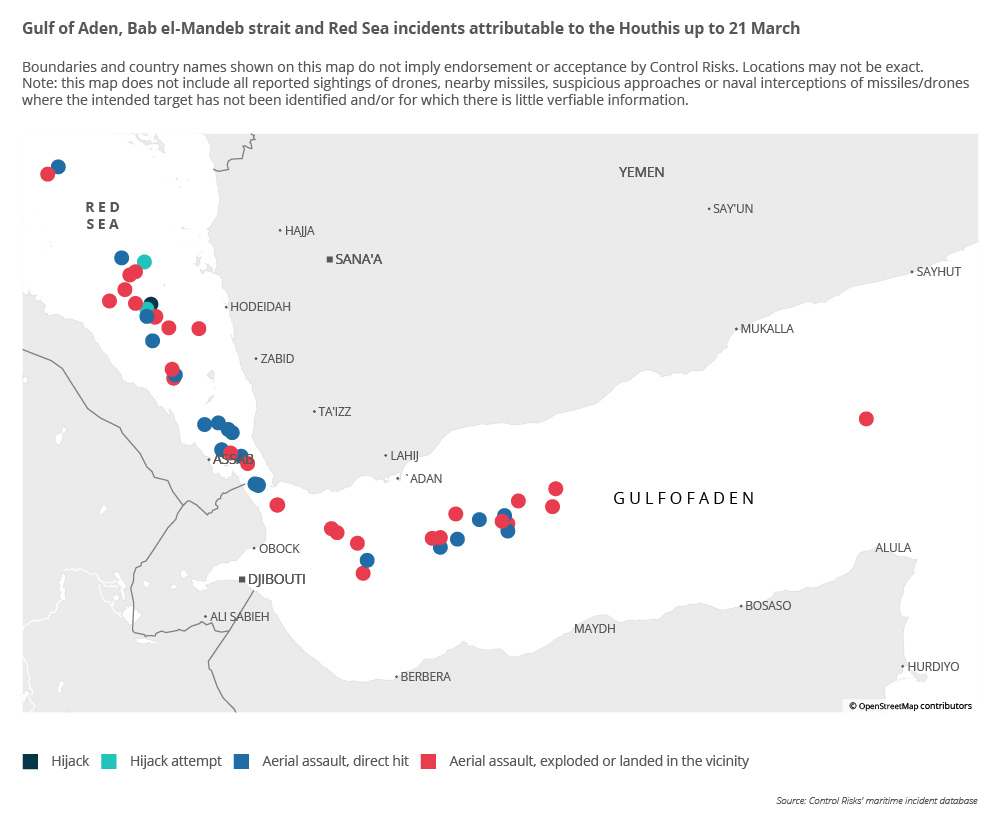This is an example of the analytical insight available on Seerist, a Control Risks company.
On 16 March, the military spokesperson of the rebel Houthi movement, Yehya Sarea, claimed that the group for the first time had targeted vessels in the Indian Ocean, which is beyond its current proven range.
- Although the 16 March assault on US- and Israel-linked vessels in the Indian Ocean remains unconfirmed, the rebels are likely to have attempted to launch an attack but failed to reach their target.
- While parts of the Indian Ocean are within range of Houthi weapons, the group is more likely to continue concentrating its force on the Southern Red Sea and the Gulf of Aden.
- The group will continue its attacks to display its power as an influential actor in Red Sea security. Attacks may intensify in the coming weeks, in part in response to expected new Israeli operations in Gaza (Palestinian Territories).
- With no demonstrated capacity to target vessels in the wider Indian Ocean, commercial ships are highly unlikely to divert away from it in the same way they have from the Red Sea.
Expanding operations?
The claimed attack followed a televised speech on 15 March by the leader of the rebel movement Abdul Malik al-Houthi, in which he expressed the movement’s intention to expand its area of operations to target Israeli-linked ships transiting the Indian Ocean towards the Cape of Good Hope (South Africa). The Houthi leader also reaffirmed that the rebel movement will continue to attack vessels in the Red Sea, the Arabian Sea, and the Gulf of Aden during the month of Ramadan (approximately until 9 April) in support of Palestinians and against Israel's military operations in Gaza.
The statement came as the Israel Defense Forces (IDF) are expected to launch an offensive on the city of Rafah (southern Gaza) in the coming weeks, where over 1.4m Palestinians are located as internal refugees compared to 300,000 before the current war.
Finding this article useful?
Alleged attack

Although neither US Central Command (CENTCOM) or other Western military sources have confirmed the incident, the Houthis have a track record of claiming or exaggerating attacks. In our assessment, it is likely that the Houthi movement did carry out an attack in which it was seeking to target vessels south of the Gulf of Aden, or on the edge of the Indian Ocean. However, the projectile probably fell far short of its target given the significant distance from the rebel group’s likely launching point – the southern coast of Hodeidah province.
The Houthis will maintain their attacks on vessels around the Red Sea over the coming weeks as the war in Gaza continues. The likelihood of the IDF’s Rafah operation taking place is expected to further fuel Houthi attacks across the group’s established area of operations in the Red Sea: the Bab El-Mandeb Strait, the Gulf of Aden, and (to a lesser extent) the Arabian Sea. The rebel movement has continued to use the war in Gaza to promote its domestic political agenda, which includes strengthening domestic support and demonstrating to the international community its ability to control the security of the strategic maritime route.
Since November 2023, the Houthis have progressively increased the intensity and range of attacks against vessels. The rebels have also utilised the campaign to test the effectiveness and limits of new and existing weapons systems. For example, the rebels have used anti-ship ballistic missiles and underwater drones, displaying new capabilities they have never used before. The full nature and sophistication of rebel-held weaponry remains unknown. Although the US and UK’s airstrike campaign has reduced some of the Houthis’ capability, the group’s ongoing efforts make clear that this has largely been redundant.
Commercial vessel impact
The latest statement from the rebel movement is unlikely to drive a significant shift in commercial vessel behaviour in the coming weeks. Although the group’s stated intent to expand its range of targeting to the Indian Ocean increases the number of vessels that could be impacted – as this could include vessels utilising the established diversion route via the Cape of Good Hope – the lack of demonstrated weapons capacity and the significant distance from likely launch sites reduces the potential for successful targeting of deep offshore vessels.
The group is more likely to focus efforts on existing target locations. While some operators may elect to sail slightly further offshore than original route planning had set, we do not expect complete diversion away from use of the waters. This is not least because it remains the sole alternative for operators who would previously have utilised the Red Sea route.
